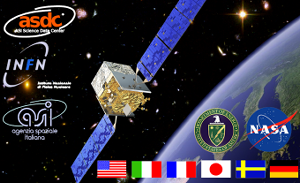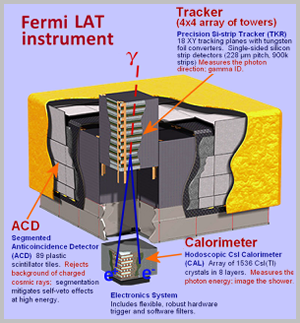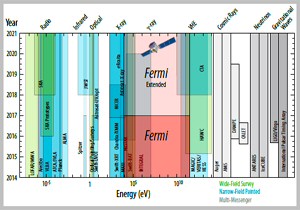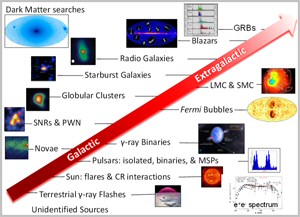The Fermi Gamma-ray Space Telescope is a powerful space observatory, characterized by huge leap in all key capabilities, working to unveil the mysteries of the high-energy universe.
Originally called the Gamma-Ray Large Area Space Telescope (GLAST), the mission was renamed for the physicist Enrico Fermi. This rechristening reflects the ongoing mysteries of the gamma-ray sky and the important Italian contribution to the instrument. Enrico Fermi, who won the 1938 Nobel Prize in Physics, is best known for building the first man-made nuclear reactor in 1942. A brilliant theoretical physicist as well, he was also the first to propose a mechanism by which powerful cosmic objects could accelerate electrons strongly enough to generate gamma rays.
The Fermi satellite studies energetic gamma-rays, observing physical processes far beyond the capabilities of earthbound laboratories, and opening a wide energy window on the universe.
The Large Area Telescope (LAT) is the principal scientific instrument on the Fermi spacecraft and it operates more like a particle detector than a conventional telescope. From within its 1.8-meter cube housing, the LAT uses 880000 silicon microstrip detectors to detect high-energy gamma rays with unprecedented resolution and sensitivity, pushing new boundaries in gamma-ray astrophysics and multifrequency/multimessenger astroparticle physics. The scientific return and the level of international cooperation is maximized studying gamma-ray photons from cosmic sources in conjunction to simultaneous data obtained from ground-based and space-borne observatories operating at other electromagnetic wavebands.
The LAT's field of view covers about 20% of the sky at any time, and it scans continuously in survey mode, covering the whole sky every three hours in a wide energy range (20 MeV to >300 GeV) with unprecedented sensibility.
Fermi was launched from Kennedy Space Center, Cape Canaveral Air Force Station, Florida, on June 11, 2008 at 12:05:52 p.m. EDT with a Delta II 7920-H "Heavy" rocket. The observatory checkout phase completed on August 11, 2008 and is now in nominal science operations. Fermi resides in a low-earth circular orbit (550 km altitude), at a 28.5 degree inclination. The mission was designed for a goal of ten years of operations and beyond.
The Fermi mission is an astrophysics and particle physics partnership, developed by NASA in collaboration with the U.S. Department of Energy, along with important contributions from academic institutions and partners in France, Germany, Italy, Japan, Sweden, and the United States. These include the Agenzia Spaziale Italiana (ASI) and the Istituto Nazionale di Fisica Nucleare (INFN) with additional support for science analysis from INAF in Italy.
The Fermi LAT scientific collaboration includes presently more than 400 scientists and students at more than 90 universities and laboratories in 12 countries, and has published scientific papers for example in the field of analysis methods, gamma-ray source catalogs, pulsars, supermassive black-hole systems and jets in active galactic nuclei, gamma-ray bursts, cosmic-ray electrons, energetic binary star systems and novae, diffuse gamma-ray emission, supernova remnants, unassociated gamma-ray sources, extragalactic gamma-ray background, solar flares, terrestrial gamma-ray flashes, searches for the mysterious dark matter for example looking at non-astrophysical diffuse excesses in the Galactic center and in dwarf spheroidal galaxies or searching evidences for axions or primordial black hole evaporation, and search for any signal of potential new laws of physics.
With Fermi, astrophysicists have a superior instrument to study the violent, variable and energetic objects and events of the high-energy Universe, like accreting black holes, neutron stars or gamma-ray bursts, while physicists are able to study subatomic particles at energies far greater than those seen in ground-based particle accelerators, and cosmologists are gaining valuable information about the early evolution of the Universe. Fermi may also probe some of the same microscopic phenomena as the LHC does at CERN, and show us how these physical processes work in their natural cosmic settings.
The 2011 Bruno Rossi Prize of the AAS was awarded to P. Michelson, W. Atwood and the Fermi-LAT Team. The 2012 Panofsky Prize of the APS was awarded to W. Atwood and the Fermi-LAT Team. In addition a Certificate of Appreciation for the construction and test of the 16 LAT modular towers in 2007, a Group Achievement Award for the successful integration, test and simulations of the LAT in 2008, and a further Group Achievement Award for the successful early operations and the discovery of new gamma-ray sources in 2010 were all awarded to the Fermi-LAT Team members by NASA.
SSDC contribution
INFN is an important member of the LAT Collaboration having built the tracker in cooperation with Italian industries, and providing a continuous support to operations and to data calibration, analysis and scientific exploitation.
The INFN Fermi team of the SSDC in particular is contributing to the mission by establishing and maintaining a mirror archive of the LAT high level data products that is addressed to data distribution, visualization and exploration, and by developing and maintaining quick-look interactive analysis tools, other science LAT data products, and interactive LAT gamma-ray source catalog tables. The team of SSDC is participating to technical and scientific activities within the international LAT collaboration like data validation, gamma-ray data analysis and science exploitation of the LAT data archive, AGN catalog productions, source population and evolution studies, multifrequency spectral/temporal data analysis, development of analysis software, duty service activities within LAT operations, coordination of LAT science groups and group services, organization of multifrequency campaigns and collection of multi-mission/instrument data. The support and tutorials about data analysis and duty shifts, development of international collaborations in data analysis and scientific research, communication of science results at conferences and public communication and outreach activity are further tasks of the team. The Fermi team of SSDC (formerly ASDC) co-organized the 3rd Fermi Symposium held in Rome in 2011 (the forthcoming is the 7th Fermi Symposium).





